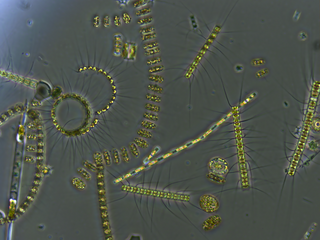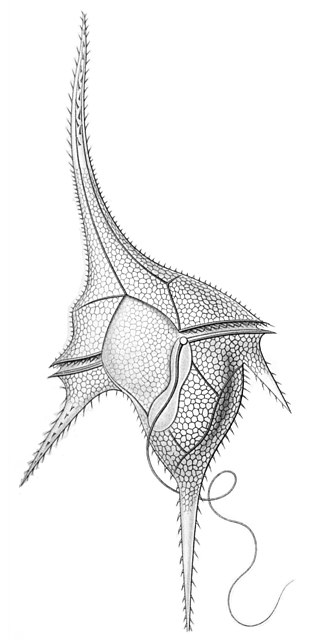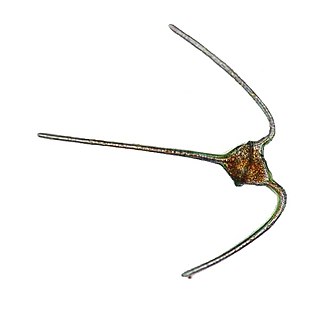
Zooplankton are the animal component of the planktonic community, having to consume other organisms to thrive. Plankton are aquatic organisms that are unable to swim effectively against currents. Consequently, they drift or are carried along by currents in the ocean, or by currents in seas, lakes or rivers.

The dinoflagellates are a monophyletic group of single-celled eukaryotes constituting the phylum Dinoflagellata and are usually considered protists. Dinoflagellates are mostly marine plankton, but they also are common in freshwater habitats. Their populations vary with sea surface temperature, salinity, and depth. Many dinoflagellates are photosynthetic, but a large fraction of these are in fact mixotrophic, combining photosynthesis with ingestion of prey.

The Noctilucales are an order of marine dinoflagellates. They differ from most others in that the mature cell is diploid and its nucleus does not show a dinokaryotic organization. They show gametic meiosis.
The Syndiniales are an order of early branching dinoflagellates, found as parasites of crustaceans, fish, algae, cnidarians, and protists. The trophic form is often multinucleate, and ultimately divides to form motile spores, which have two flagella in typical dinoflagellate arrangement. They lack a theca and chloroplasts, and unlike all other orders, the nucleus is never a dinokaryon. A well-studied example is Amoebophrya, which is a parasite of other dinoflagellates and may play a part in ending red tides. Several MALV groups have been assigned to Syndiniales; recent studies, however, show paraphyly of MALVs suggesting that only those groups that branch as sister to dinokaryotes belong to Syndiniales.

The genus Ceratium is restricted to a small number of freshwater dinoflagellate species. Previously the genus contained also a large number of marine dinoflagellate species. However, these marine species have now been assigned to a new genus called Tripos. Ceratium dinoflagellates are characterized by their armored plates, two flagella, and horns. They are found worldwide and are of concern due to their blooms.

The Gymnodiniales are an order of dinoflagellates, of the class Dinophyceae. Members of the order are known as gymnodinioid or gymnodinoid. They are athecate, or lacking an armored exterior, and as a result are relatively difficult to study because specimens are easily damaged. Many species are part of the marine plankton and are of interest primarily due to being found in algal blooms. As a group the gymnodinioids have been described as "likely one of the least known groups of the open ocean phytoplankton."

Oxyrrhis is a genus of heterotrophic dinoflagellate, the only genus in the family Oxyrrhinaceae. It inhabits a range of marine environments worldwide and is important in the food web dynamics of these ecosystems. It has the potential to be considered a model organism for the study of other protists. Oxyrrhis is an early-branching lineage and has long been described in literature as a monospecific genus, containing only Oxyrrhis marina. Some recent molecular phylogenetic studies argue that Oxyrrhis comprises O. marina and O. maritima as distinct species, while other publications state that the two are genetically diverse lineages of the same species. The genus has previously been suggested to contain O. parasitica as a separate species, however the current consensus appears to exclude this, with Oxyrrhis being monospecific and containing O. marina and O. maritima as separate lineages of the type species. The genus is characterised by its elongated body which is anteriorly prolonged to a point, its complex flagellar apparatuses which attach to the ventral side of the cell, and the unique features of its nucleus.
Amoebophyra is a genus of dinoflagellates. Amoebophyra is a syndinian parasite that infects free-living dinoflagellates that are attributed to a single species by using several host-specific parasites. It acts as "biological control agents for red tides and in defining species of Amoebophrya." Researchers have found a correlation between a large amount of host specify and the impact host parasites may have on other organisms. Due to the host specificity found in each strain of Amoebophrya's physical makeup, further studies need to be tested to determine whether the Amoebophrya can act as a control against harmful algal blooms.

Ornithocercus is a genus of planktonic dinoflagellate that is known for its complex morphology that features considerable lists growing from its thecal plates, giving an attractive appearance. Discovered in 1883, this genus has a small number of species currently categorized but is widespread in tropical and sub-tropical oceans. The genus is marked by exosymbiotic bacteria gardens under its lists, the inter-organismal dynamics of which are a current field of research. As they reside only in warm water, the genus has been used as a proxy for climate change and has potential to be an indicator species for environmental change if found in novel environments.

Akashiwo sanguinea is a species of marine dinoflagellates well known for forming blooms that result in red tides. The organism is unarmored (naked). Therefore, it lacks a thick cellulose wall, the theca, common in other genera of dinoflagellates. Reproduction of the phytoplankton species is primarily asexual.

Oxyrrhis marina is a species of heterotrophic dinoflagellate with flagella that is widely distributed in the world's oceans.

Cochlodinium polykrikoides is a species of red tide producing marine dinoflagellates known for causing fish kills around the world, and well known for fish kills in marine waters of Southeast Asia. C. polykrikoides has a wide geographic range, including North America, Central America, Western India, Southwestern Europe and Eastern Asia. Single cells of this species are ovoidal in shape, 30-50μm in length and 25-30μm in width.

The Polykrikaceae are a family of athecate dinoflagellates of the order Gymnodiniales. Members of the family are known as polykrikoids. The family contains two genera: Polykrikos and Pheopolykrikos.

Erythropsidinium is a genus of dinoflagellates of the family Warnowiaceae.

Tripos is a genus of marine dinoflagellates in the family Ceratiaceae. It was formerly part of Ceratium, then separated out as Neoceratium, a name subsequently determined to be invalid.
Tripos elegans is a species of dinoflagellates in the family Ceratiaceae.

Dinoflagellates are eukaryotic plankton, existing in marine and freshwater environments. Previously, dinoflagellates had been grouped into two categories, phagotrophs and phototrophs. Mixotrophs, however include a combination of phagotrophy and phototrophy. Mixotrophic dinoflagellates are a sub-type of planktonic dinoflagellates and are part of the phylum Dinoflagellata. They are flagellated eukaryotes that combine photoautotrophy when light is available, and heterotrophy via phagocytosis. Dinoflagellates are one of the most diverse and numerous species of phytoplankton, second to diatoms.
Torodinium (ˌtɔɹoʊˈdɪniəm) is a genus of unarmored dinoflagellates and comprises two species, Torodinium robustum and the type species Torodinium teredo. The establishment of Torodinium, as well as the characterization of the majority of its morphology, occurred in 1921 and further advances since have been slow. Lack of research is largely due to its extremely fragile and easily deformed nature, which also renders fossil records implausible. The genus was originally characterized by torsion of the sulcus and a posterior cingulum. Since then, new distinctive features have been discovered including an extremely reduced hyposome, a longitudinally ribbed episome, and a canal on the dextro-lateral side. Further investigation into the function of many anatomical features is still necessary for this genus.

Marine protists are defined by their habitat as protists that live in marine environments, that is, in the saltwater of seas or oceans or the brackish water of coastal estuaries. Life originated as marine single-celled prokaryotes and later evolved into more complex eukaryotes. Eukaryotes are the more developed life forms known as plants, animals, fungi and protists. Protists are the eukaryotes that cannot be classified as plants, fungi or animals. They are mostly single-celled and microscopic. The term protist came into use historically as a term of convenience for eukaryotes that cannot be strictly classified as plants, animals or fungi. They are not a part of modern cladistics because they are paraphyletic.
Warnowia is a genus of athecate dinoflagellates, characterized by having a very sophisticated photoreceptor organelle called the ocelloid. This genus is dispersed worldwide but is scarce and difficult to find and nearly impossible to culture. As a result, the history and taxonomy of this genus are confusing at best, and many basic characteristics like its life cycle are still unknown. Still, Warnowia has drawn scientific interest as a unicellular organism with a fascinatingly complex photoreceptor system.














